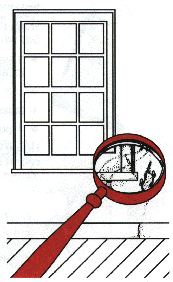HUD and EPA mandated Lead Booklet
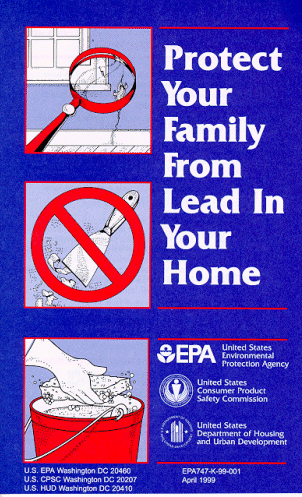 |
|
If you think your home has high levels of lead: |
ARE YOU PLANNING TO BUY, RENT, OR RENOVATE A HOME BUILT BEFORE 1978?
Many houses and apartments built before 1978 have paint that contains lead (called lead-based paint). Lead from paint, chips, and dust can pose serious health hazards if not taken care of properly. By 1996, federal law will require that individuals receive certain information before renting, buying, or renovating pre-1978 housing:
 | LANDLORDS will have to disclose known information on lead-based paint hazards before leases take effect. Leases will include a federal form about lead-based paint.
SELLERS will have to disclose known information on lead-based
paint hazards before selling a house. Sales contracts will
include a federal form about lead-based paint in the building.
Buyers will have up to 10 days to check for lead hazards.
RENOVATORS will have to give you this pamphlet before starting
work. If you want more information on these requirements, call the National Lead Information Clearinghouse at 1-800-424-LEAD. |
This document is in the public domain. It may be reproduced by an individual or organization without permission. Information provided in this booklet is based upon current scientific and technical understanding of the issues presented and is reflective of the jurisdictional boundaries established by the statutes governing the co-authoring agencies. Following the advice given will not necessarily provide complete protection in all situations or against all health hazards that can be caused by lead exposure.
IMPORTANT!
*Lead From Paint, Dust, and Soil Can Be Dangerous If Not Managed Properly*
|
LEAD GETS IN THE BODY IN MANY WAYS
*1 out of every 11 children in the United States has dangerous levels of lead in the bloodstream.**Even children who appear healthy can have dangerous levels of lead.* |
People can get lead in their body if they:
|
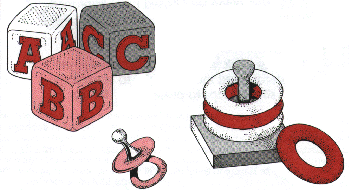
Lead's Effects
If not detected early, children with high levels of lead in their bodies can suffer from:
- Damage to the brain and nervous system
- Behavior and learning problems (such as hyperactivity)
- Slowed growth
- Hearing problems
- Headaches
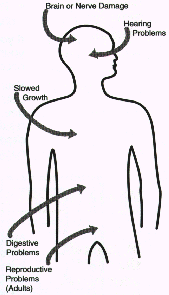
- Difficulties during pregnancy
- Other reproductive problems (in both men and women)
- High blood pressure
- Digestive problems
- Nerve disorders
- Memory and concentration problems
- Muscle and joint pain
CHECKING YOUR FAMILY FOR LEAD
*Get your children tested if you think your home has high levels of lead.* |
A simple blood test can detect high levels of lead. Blood tests are important for:
Your doctor or health center can do blood tests. They are inexpensive and sometimes free. Your doctor will explain what the test results mean. Treatment can range from changes in your diet to medication or a hospital stay. |
WHERE LEAD-BASED PAINT IS FOUND
*In general, the older your home, the more likely it has lead-based paint. * |
Many homes built before 1978 have lead-based paint. In 1978, the federal government banned lead-based paint from housing. Lead can be found:
|
WHERE LEAD IS LIKELY TO BE A HAZARD
|
Lead-based paint that is in good condition is usually not a
hazard.
Peeling, chipping, chalking, or cracking lead-based paint is a hazard and needs immediate attention.
Lead-based paint may also be a hazard when found on surfaces that
children can chew or that get a lot of wear-and-tear. These areas
include:
 objects
that people touch. Settled lead dust can reenter the air when
people vacuum, sweep, or walk through it. objects
that people touch. Settled lead dust can reenter the air when
people vacuum, sweep, or walk through it.
Lead in soil can be a hazard when children play in bare soil or when people bring soil into the house on their shoes. Call your state agency (see below) to find out about soil testing for lead. |
*Lead from paint chips, which you can see, and lead dust, which you can't always see, can both be serious hazards.* |
CHECKING YOUR HOME FOR LEAD HAZARDS
*Just knowing that a home has lead-based paint may not tell you if there is a hazard.*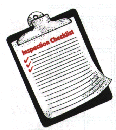 |
You can get your home checked for lead hazards in one of two
ways, or both:
Trained professionals use a range of methods when checking your home, including:
|
WHAT YOU CAN DO NOW TO PROTECT YOUR FAMILY
If you suspect that your house has lead hazards, you can take
some immediate steps to reduce your family's risk: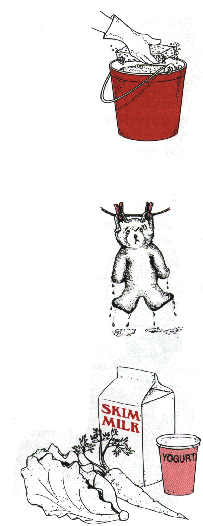
- If you rent, notify your landlord of peeling or chipping paint.
- Clean up paint chips immediately.
- Clean floors, window frames, window sills, and other surfaces weekly. Use a mop or sponge with warm water and a general all-purpose cleaner or a cleaner made specifically for lead. REMEMBER: NEVER MIX AMMONIA AND BLEACH PRODUCTS TOGETHER SINCE THEY CAN FORM A DANGEROUS GAS.
- Thoroughly rinse sponges and mop heads after cleaning dirty or dusty areas.
- Wash children's hands often, especially before they eat and before nap time and bed time.
- Keep play areas clean. Wash bottles, pacifiers, toys, and stuffed animals regularly.
- Keep children from chewing window sills or other painted surfaces.
- Clean or remove shoes before entering your home to avoid tracking in lead from soil.
- Make sure children eat nutritious, low-fat meals high in iron
and calcium, such as spinach and low-fat dairy products. Children
with good diets absorb less lead.
HOW TO SIGNIFICANTLY REDUCE LEAD HAZARDS
*Removing lead improperly can increase the hazard to your family by spreading even more lead dust around the house.**Always use a professional who is trained to remove lead hazards safely.* 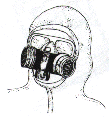 |
In addition to day-to-day cleaning and good nutrition:
Call your state agency (see below) for help with locating qualified contractors in your area and to see if financial assistance is available. |
REMODELING OR RENOVATING A HOME WITH LEAD-BASED PAINT
Take precautions before you begin remodeling or renovations that
disturb painted surfaces (such as scraping off paint or tearing
out walls):
| 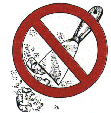 *If not conducted properly, certain types of renovations can release lead from paint and dust into the air.*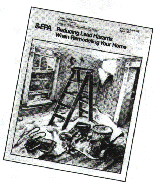 |
OTHER SOURCES OF LEAD
 *While paint, dust, and soil are the most common lead hazards, other lead sources also exist.* |
|
FOR MORE INFORMATION
The National Lead Information Center
Call 1-800-LEAD-FYI to learn how to protect children from lead poisoning. For other information on lead hazards, call the center's clearinghouse at 1-800-424-LEAD. For the hearing impaired, call, TDD 1-800-526-5456 (FAX: 202-659-1192, Internet: EHC@CAIS.COM).
EPA's Safe Drinking Water Hotline
Call 1-800-426-4791 for information about lead in drinking water.
Consumer Product Safety Commission Hotline
To request information on lead in consumer products, or to report an unsafe consumer product or a product-related injury call 1-800-638-2772. (Internet: info@cpsc.gov). For the hearing impaired, call TDD 1-800-638-8270.
STATE HEALTH AND ENVIRONMENTAL AGENCIES
Some cities and states have their own rules for lead-based paint
activities. Check with your state agency to see if
state or local laws apply to you. Most state agencies can also
provide information on finding a lead abatement firm in your
area, and on possible sources of financial aid for reducing lead
hazards. Go to www.epa.gov/lead for contacts.
EPA REGIONAL OFFICES
| Your Regional EPA Office can provide further information
regarding regulations and lead protection programs.
EPA Regional Offices
Region 1 (Connecticut, Massachusetts, Maine, New Hampshire, Rhode
Island, Vermont)
Region 2 (New Jersey, New York, Puerto Rico, Virgin Islands)
Building 5
Region 3 (Delaware, Washington DC, Maryland, Pennsylvania,
Virginia, West Virginia)
Region 4 (Alabama, Florida, Georgia, Kentucky, Mississippi, North
Carolina, South Carolina, Tennessee) |
Region 5 (Illinois, Indiana, Michigan, Minnesota, Ohio,
Wisconsin) 77 West Jackson Boulevard Chicago, IL 60604-3590 (312) 886-6003
Region 6 (Arkansas, Louisiana, New Mexico, Oklahoma, Texas)
First Interstate Bank Tower
Region 7 (Iowa, Kansas, Missouri, Nebraska)
726 Minnesota Avenue
Region 8 (Colorado, Montana, North Dakota, South Dakota, Utah,
Wyoming)
Region 9 (Arizona, California, Hawaii, Nevada)
75 Hawthorne Street
Region 10 (Idaho, Oregon, Washington, Alaska)
1200 Sixth Avenue |
CPSC REGIONAL OFFICES
| Eastern Regional Center 6 World Trade Center Vesey Street, Room 350 New York, NY 10048 (212) 466-1612
Central Regional Center
Western Regional Center |
|
Lead Office Overview | Lead-Based Paint Hazard Control Grant Program | Technical Studies & Regulations Development | Community Outreach Activities & News |
